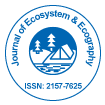Our Group organises 3000+ Global Conferenceseries Events every year across USA, Europe & Asia with support from 1000 more scientific Societies and Publishes 700+ Open Access Journals which contains over 50000 eminent personalities, reputed scientists as editorial board members.
Open Access Journals gaining more Readers and Citations
700 Journals and 15,000,000 Readers Each Journal is getting 25,000+ Readers
Google Scholar citation report
Citations : 2854
Journal of Ecosystem & Ecography received 2854 citations as per Google Scholar report
Journal of Ecosystem & Ecography peer review process verified at publons
Indexed In
- CAS Source Index (CASSI)
- Index Copernicus
- Google Scholar
- Sherpa Romeo
- Online Access to Research in the Environment (OARE)
- Open J Gate
- Genamics JournalSeek
- Ulrich's Periodicals Directory
- Access to Global Online Research in Agriculture (AGORA)
- Electronic Journals Library
- RefSeek
- Hamdard University
- EBSCO A-Z
- OCLC- WorldCat
- SWB online catalog
- Virtual Library of Biology (vifabio)
- Publons
- Geneva Foundation for Medical Education and Research
- Euro Pub
Useful Links
Recommended Journals
Share This Page
Effects of bacterial inoculants on soil microbiomes and biodegradation in hydrocarbon contaminated soils
Joint Conference International Conference on Environmental Microbiology and Microbial Ecology & International Conference on Ecology and Ecosystems
Coppotelli B M
Center for Research and Development in Industrial Fermentation (CINDEFI) La Plata, Argentina
ScientificTracks Abstracts: J Ecosyst Ecography
Abstract
Over the years, we have collected different bacterial strains belonging to sphingomonadaceae family, which have in common the ability to degrade PAH (polycyclic aromatic hydrocarbons). Their genomes have been fully sequenced (WGS) showing similarities in genes codifying enzymes involved in PAH degradation. All of them showed different degradation kinetics in cultures with phenanthrene as sole carbon source. This differences were confirmed when were inoculated in soil contaminated with phenanthrene. The bioaugmentation of the strain Sphingomonas paucimobilis 20006FA revealed a reduction in genetic and functional diversity of soil, and the accumulation of toxic phenanthrene metabolites reducing efficiency in phenanthrene degradation. This effect was not observed when a similar experiment was performed with Sphingobium sp. AM strain, suggesting that despite coding for the same enzymes the genes of the strains would be regulated differently. The effect of the inoculation with strain 20006FA and Sphingobium sp. 22B (more resistant to C-starvation and drying conditions) on contaminated soil in a desiccation environment, suggests that strain 22B is the most suitable due to its adaptation to the usual environmental conditions. The effect of bioaugmentation with Sphingobium sp. AM strain on different soils microbiomes (chronically and recently contaminated soil) revealed an increase in the richness and diversity (pyrosequencing) in both contaminated microbiomes. An improvement in the elimination of phenanthrene occurred only in recently contaminated soil. In all cases, there was evidence of the establishment of the inoculants, which occurred together with the modification of the microbiome of the soils. It was verified that the establishment of an inoculant in the soil does not necessarily correlate with the increase of the desired catabolic capacities, in our case the degradation of PAH, because it could have been established in function of other resources. We have observed that efficiency of an inoculant in soil is not directly related to its genetic potential but to other physiological properties, which could be translated in a distinctive environmental behavior.Biography
Coppotelli B M has her expertise in microbial bioremediation and passion in contributing to environmental care. Her studies on hydrocarbon degrading bacterial strains and consortia have contributed to the world of microbial ecology, getting insight into ecology that drives bacterial communities in response to inoculation and biochemical processes of contaminant elimination in soils and sediments and interactions among bacterial community members. It allows contributing our understanding and helping in designing appropriate management and cleanup of contaminated ecosystems.

 Spanish
Spanish  Chinese
Chinese  Russian
Russian  German
German  French
French  Japanese
Japanese  Portuguese
Portuguese  Hindi
Hindi 
